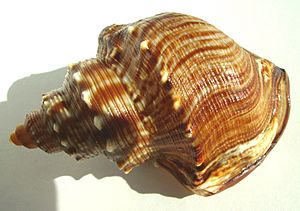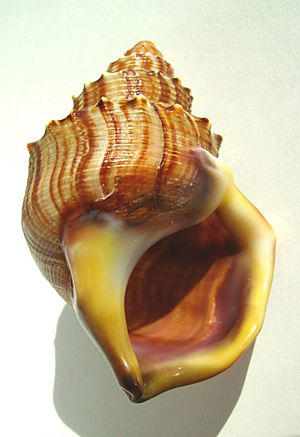Struthiolaria papulosa facts for kids
Quick facts for kids Struthiolaria papulosa |
|
|---|---|
 |
|
| A dorsal view of a shell of Struthiolaria papulosa | |
| Scientific classification | |
| Kingdom: | |
| Phylum: | |
| Class: | |
| (unranked): |
clade Caenogastropoda
clade Hypsogastropoda clade Littorinimorpha |
| Superfamily: |
Stromboidea
|
| Family: |
Struthiolariidae
|
| Genus: | |
| Species: |
S. papulosa
|
| Binomial name | |
| Struthiolaria papulosa (Martyn, 1784)
|
|
| Synonyms | |
|
|
The Struthiolaria papulosa, often called the "ostrich foot snail" or "ostrich foot shell", is a type of medium-sized sea snail. It is a marine mollusc, which means it is an animal with a soft body, often protected by a shell, that lives in the ocean. This particular snail belongs to a group of animals called gastropods.
Contents
About the Ostrich Foot Snail
The ostrich foot snail is a fascinating creature found in the ocean. It gets its common name from the shape of its shell, which some people think looks a bit like an ostrich's foot. This snail is part of a large family of sea snails known as Struthiolariidae.
What is a Gastropod?
Gastropods are a very diverse group of animals. They are a type of mollusc, which also includes clams, oysters, and octopuses. Most gastropods, like the ostrich foot snail, have a single, spiral shell. They move around using a muscular "foot" on their underside.
Where S. papulosa Lives
The Struthiolaria papulosa is native to the waters around New Zealand. It lives in marine environments, usually on sandy or muddy seabeds. These snails can be found in shallow coastal areas as well as in deeper waters. They are well-adapted to living on the ocean floor.
What the Shell Looks Like
The shell of the Struthiolaria papulosa is quite distinctive. It is usually a pale color, often yellowish or brownish. The shell has a spiral shape, and its surface can be bumpy or "papulose," which is where the snail gets part of its scientific name. These bumps or nodules help protect the snail. The opening of the shell, called the aperture, is where the snail's body comes out.
How it Eats
Like many sea snails, the ostrich foot snail is likely a detritivore. This means it feeds on detritus, which is dead organic material that sinks to the bottom of the ocean. They might also filter small particles of food from the water. Snails use a special ribbon-like tongue called a radula to scrape or collect their food.
Life Cycle and Reproduction
Sea snails like the Struthiolaria papulosa reproduce by laying eggs. The eggs are often laid in protective capsules or masses. Once the eggs hatch, tiny larval snails emerge. These larvae might float in the water for a period before settling down on the seabed and growing into adult snails. The life cycle ensures the continuation of the species in its marine habitat.
See also
 In Spanish: Struthiolaria papulosa para niños
In Spanish: Struthiolaria papulosa para niños


